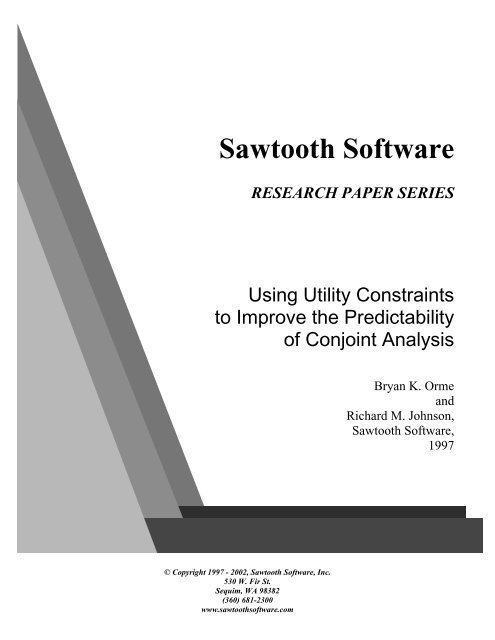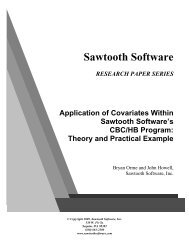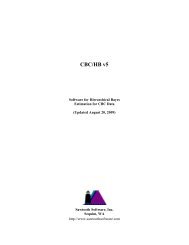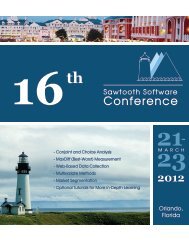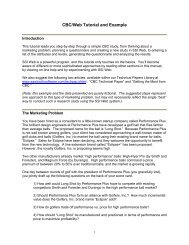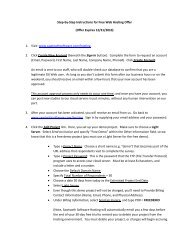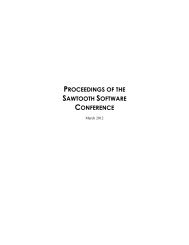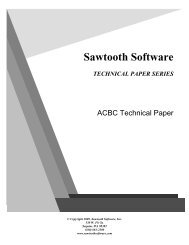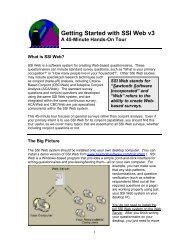Using Utility Constraints to Improve the Predictability of Conjoint ...
Using Utility Constraints to Improve the Predictability of Conjoint ...
Using Utility Constraints to Improve the Predictability of Conjoint ...
Create successful ePaper yourself
Turn your PDF publications into a flip-book with our unique Google optimized e-Paper software.
Saw<strong>to</strong>oth S<strong>of</strong>twareRESEARCH PAPER SERIES<strong>Using</strong> <strong>Utility</strong> <strong>Constraints</strong><strong>to</strong> <strong>Improve</strong> <strong>the</strong> <strong>Predictability</strong><strong>of</strong> <strong>Conjoint</strong> AnalysisBryan K. OrmeandRichard M. Johnson,Saw<strong>to</strong>oth S<strong>of</strong>tware,1997© Copyright 1997 - 2002, Saw<strong>to</strong>oth S<strong>of</strong>tware, Inc.530 W. Fir St.Sequim, WA 98382(360) 681-2300www.saw<strong>to</strong>oths<strong>of</strong>tware.com
A Dissenting OpinionThe May 1995 Journal <strong>of</strong> Marketing Research included an article by Allenby, Arora and Ginter(hereafter, AAG) entitled, “Incorporating Prior Knowledge in<strong>to</strong> <strong>the</strong> Analysis <strong>of</strong> <strong>Conjoint</strong> Studies.” AAGreported that prohibiting sign reversals in ACA resulted in significant improvements. AAG proposed aninteresting new method using <strong>the</strong> Gibbs sampler <strong>to</strong> estimate constrained part worths. They “held out” <strong>the</strong>last three pairs from an ACA interview for external validation. AAG measured performance with a meansquared error measure using draws from <strong>the</strong> posterior distribution <strong>of</strong> model parameters, finding <strong>the</strong>median MSE for <strong>the</strong> held out pairs <strong>to</strong> be about 4.60 for standard ACA estimates and 3.52 whenconstraints were imposed. AAG concluded that imposing utility constraints via <strong>the</strong> Gibbs sampler hadimproved <strong>the</strong> quality <strong>of</strong> ACA utilities.Ano<strong>the</strong>r Look at AAG’s FindingsJohnson and Pinnell (1995) examined <strong>the</strong> same data in terms <strong>of</strong> <strong>the</strong> more commonly accepted validationmeasure <strong>of</strong> holdout hit-rates. AAG provided <strong>the</strong>ir part worth estimates, for both standard and Bayesmethods. Johnson and Pinnell found that hit rates for <strong>the</strong> held out pairs were 95% for standard ACA and86% for Bayes (t=10.99). <strong>Constraints</strong> had actually been harmful <strong>to</strong> prediction. The data set also includedfour holdout choice tasks that AAG had not considered. Hit rates for those additional holdouts were83.2% for standard ACA and 83.3% for Bayes. The difference is not significant (t=.36). Johnson andPinnell concluded that <strong>the</strong> Bayes method for imposing utility constraints had not significantly improved<strong>the</strong> predictability <strong>of</strong> ACA utilities.It is important <strong>to</strong> note <strong>the</strong> AAG imposed order constraints for attributes such as brand (which do not havea universal order) based upon stated preferences from <strong>the</strong> priors portion <strong>of</strong> <strong>the</strong> ACA interview. Wesuspect that stated preferences might not always represent “truth” for every respondent. Somerespondents may have been confused by <strong>the</strong> stated preference question, thus providing bad informationfor use in constraints. We expect that Bayesian methods may provide modest improvement for ACA datasets when used only for constraining strong a priori attributes and look forward <strong>to</strong> more evidence <strong>of</strong> <strong>the</strong>irusefulness in <strong>the</strong> future.Suggestions for PracticeWe think it is reasonable <strong>to</strong> correct reversals for attributes with strong a priori ordering no matter <strong>the</strong>conjoint method. Our full-pr<strong>of</strong>ile system (CVA) lets <strong>the</strong> researcher prescribe order constraints underei<strong>the</strong>r OLS or mono<strong>to</strong>ne regression. The CBC system can impose order constraints only under <strong>the</strong> LatentClass add-on module.ACA is less susceptible <strong>to</strong> reversals than full-pr<strong>of</strong>ile methods, but reversals still can occur. The currentversion <strong>of</strong> ACA influences, but does not strictly constrain, utility orders. We may include suchconstraints in future releases. For <strong>the</strong> time being, ACA users should be aware <strong>of</strong> <strong>the</strong> issue and examine<strong>the</strong>ir data sets. Counting reversals by respondent can provide an additional data point beyond <strong>the</strong>“correlation” recorded in <strong>the</strong> utility file for judging respondent reliability. You may find it useful <strong>to</strong>discard <strong>the</strong> most unreliable respondents. For those cases that remain, simply tieing <strong>of</strong>fending levels, if<strong>the</strong>re are any, can be a simple yet effective remedy.3
ReferencesAllenby, Greg M., Neeraj Arora, and James L. Ginter (1995), “Incorporating Prior Knowledge in<strong>to</strong> <strong>the</strong>Analysis <strong>of</strong> <strong>Conjoint</strong> Studies,” Journal <strong>of</strong> Marketing Research, (May), 152-62.Herman, Steve and Rob Klein (1995), “Improving <strong>the</strong> Predictive Power <strong>of</strong> <strong>Conjoint</strong> Analysis,”Marketing Research, (Fall) Vol. 7 No. 4, 29-31.Johnson, Richard M. and Jonathan Pinnell (1995), “Comment on “Incorporating Prior Knowledge in<strong>to</strong> <strong>the</strong>Analysis <strong>of</strong> <strong>Conjoint</strong> Studies,” Working Paper, Saw<strong>to</strong>oth S<strong>of</strong>tware, Sequim, WA.Moore, William L., Raj B. Myhta and Teresa M. Pavia (1994), “A Simplified Method <strong>of</strong> ConstrainedParameter Estimation in <strong>Conjoint</strong> Analysis,” Marketing Letters 5:2, 173-81.Orme, Bryan K., Mark Alpert and Ethan Christensen (1997), “Assessing <strong>the</strong> Validity <strong>of</strong> <strong>Conjoint</strong>Analysis—Continued,” Working Paper, Saw<strong>to</strong>oth S<strong>of</strong>tware, Sequim, WA.Srinivasan, V., Arun K. Jain, and Naresh K. Malhotra (1983), “Improving Predictive Power <strong>of</strong> <strong>Conjoint</strong>Analysis by Constrained Parameter Estimation,” Journal <strong>of</strong> Marketing Research, (November), 433-38.van der Lans, Ivo A., Dick R. Wittink, Joel Huber and Marco Vriens (1992), “Within- and Across-Attribute <strong>Constraints</strong> in ACA and Full Pr<strong>of</strong>ile <strong>Conjoint</strong> Analysis,” Saw<strong>to</strong>oth S<strong>of</strong>tware ConferenceProceedings, 365-79.4


